Social proof: let your visitors sell for you

Consumers have more and more metrics to draw on when shopping online: customer satisfaction, the number of products purchased, how popular particular pieces of content are. This is because of something called social proof.
Social proof is an essential lever in your digital strategy because it enables you to highlight the real experience of consumers and use this to help win future customers.
When used strategically, social proof can increase visitor engagement, conversions and customer loyalty.
In this article, we will discuss:
- What is social proof?
- Why use social proof on your website?
- How to use social proof on your website
- How to send the right social proof messages to the right visitors
- Don’t miss out on the opportunities social proof offers
1 What is social proof?
Social proof is a marketing lever, but first and foremost it is a powerful sociological phenomenon, whereby individuals are strongly influenced by the behavior and choices of a larger group of people.
As consumers, we experience this every day. Our brains are more inclined to take up an idea if it is supported by many other people. That is why we are generally attracted to films and books that are praised by critics or to bars and restaurants that are full to overflowing with customers.
Marketers now use social proof as a strategic way of increasing conversion rates and sales by creating a sense of urgency in visitors.
According to a 2025 survey, 75% of consumers read online reviews regularly—or always. It is more important than ever for online businesses to leverage social proof to influence purchasing decisions in favor of your brand.
,
The three principles of social proof
Social proof is underpinned by three different factors:
- The number or variety of sources. The “multiple source” effect is when an individual gives greater weight to an idea, product or service that is recommended by several people or sources. In an e-commerce context this is evident on product pages, where the number of customer reviews, whether positive or negative, can accelerate a potential buyer’s decision making.
- The uncertainty effect. Uncertainty is one of the main fuels of social proof. The more a potential customer hesitates about converting, the higher the chance social proof bias will play an important role in their final decision.
- The sense of belonging to a group. When an individual identifies with other people who share the same characteristics (whether around geography, preferences or shared history, for example), it is likely that they will adopt the same behavior. This theory was confirmed by the use of “canned laughter," which shows that we laugh longer and with more intensity when we perceive that other people with similar interests are also laughing.
,
2 Why use social proof on your website?
Social proof can help you achieve two main goals on your website:
- Increase conversions. According to the Word of Mouth Report by ChatterMatters, 83% of consumers said that recommendations from other buyers convince them to buy products or services. What this shows is that recommendations are the most important asset to highlight in order to build trust with your customers.
- Retain visitors and improve engagement. Sharing social proof messages contributes to creating a community on your website. Visitors are offered a high-quality experience when they can rely on the expertise of other buyers.
3 How to use social proof on your website
1. Identify the best use cases for your website
Social proof is a great way to increase visitor conversions, engagement and retention. However, these messages should be part of a well-defined strategy or they risk marring the visitor experience.
Here are a few examples of use cases which help you find the right experience for your visitors:
Show which products are the most popular in the visitor’s geographical area
To encourage your visitors to browse more product pages and add items to their cart, you can display item suggestions based on their tastes and current trends.
As an example, here is what we could display on a retail website where we have identified that our visitor is interested in women’s clothing and is located in Paris.
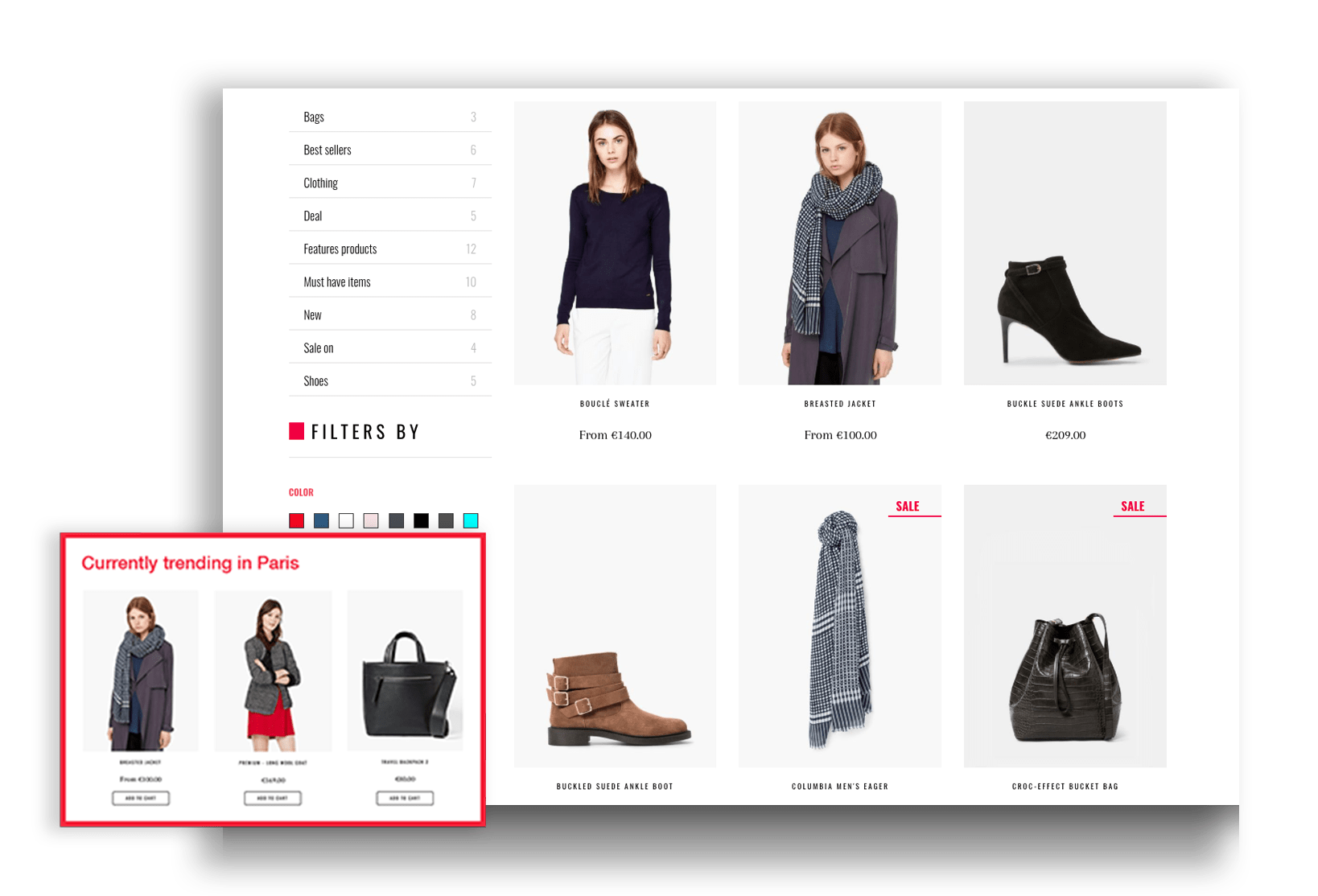
Dynamically rearrange your carousels according to product popularity
Our clients often have trouble deciding on the order of a menu or of the different slides in a carousel. With Kameleoon’s Product & Price Targeting, you can track the popularity of certain products, product categories, or services in real-time, re-arrange your carousels and menus according to their popularity and, as a result, better contextualize your visitors’ experience.
In this example, the positioning of the “bags” tab varies depending on the popularity of the associated product pages (number of clicks, add-to-carts, purchases). The more engagement this product category generates, the more the tab in question moves “up” in the carousel.

Show the number of visitors currently on a product page
Another way to use social proof to attract visitors to product pages and encourage them to convert is to display the number of visitors that are on the page in real-time.
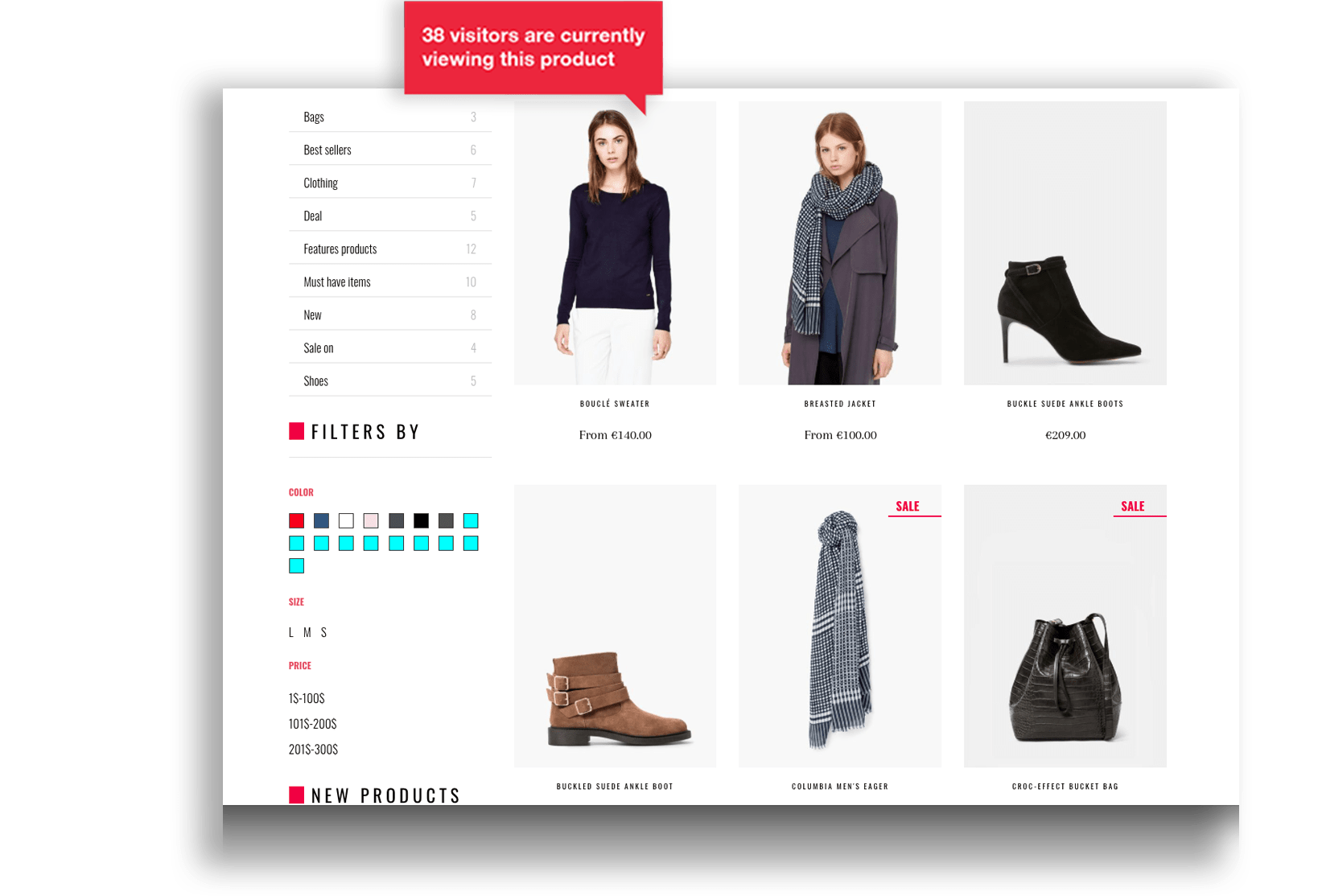
,
The group effect only really comes into play once you’ve hit a certain number of people. With Kameleoon, you could decide, for example, to only display this information once there are more than 30 visitors on a product page.

Soumaya Ouanes
Customer Success Team Leader
,
In an e-commerce context, you could also opt for a counter that shows how many add-to-carts or sales there have been over the course of a day. This creates a sense of urgency among your visitors based on the group effect.
Indicate stock volumes in real-time
Show the stock volume in real-time by connecting Kameleoon’s API to your inventory management solution.
To successfully create urgency, it is best to only show stock amounts when it is running low.
,
Unlike a visitor counter on a product page, whose effectiveness increases as the number rises, here the lower your stocks are, the more your visitors will feel pressured by time. You could, for example, decide to disclose this type of information to your visitors once you have fewer than 10 units in stock.

Noémie Sauvage
Customer Success Team Leader
,
Show the number of purchases made in real-time on your product pages
Your visitors have no way of knowing how much stock you have. By showing them how many times a particular product was purchased by your other customers, you can create a sense of urgency in a visitor.
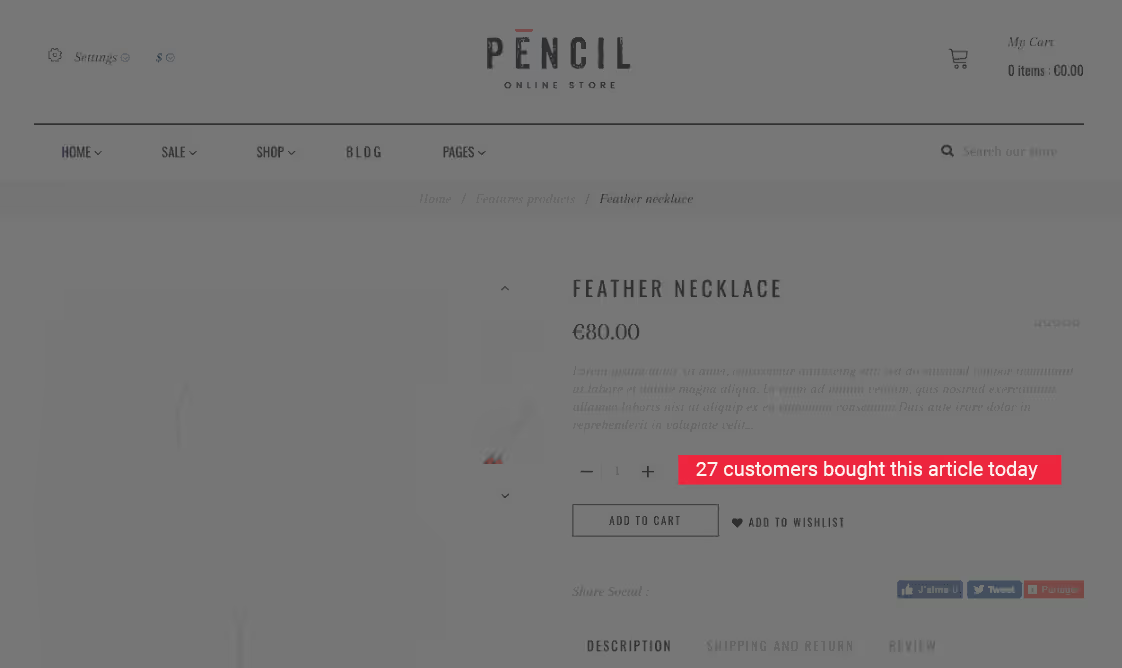
,
Be aware though that the sense of urgency will be greater if you count the purchases made over a short period of time (day/week). By indicating that x number of people have made a purchase over the last 30 days you risk achieving the opposite of your aim. You could, for example, configure this counter so that it only appears once 20 visitors have purchased a product within the last 48 hours.

Caroline André
Customer Success Team Leader
,
Display the most popular categories
Placing the most popular content in the forefront is a strategy frequently used by major media websites.
Netflix is a textbook case when it comes to social proof. It highlights its variety of content according to several criteria, including:
- Current trends. What are other Netflix users watching?
- Critically acclaimed and “most popular” content.
While the recommendations based on each individual’s viewing can never be perfect, content highlighted based on social proof is always pertinent, because it is based on the viewing habits of the entire Netflix community.

Use your numbers as proof to convince visitors of the quality of your service
To get visitors to engage with your brand, it’s in your best interest to draw on your community.
The newsletter subscription pop-in is a classic that is now used everywhere, but often it lacks appeal (and personalization).
A great counterexample can be found at Hubspot, which is very successful at capturing its blog readers’ attention by using social proof and personalizing the messages displayed based on the content read by the visitor.
If you read a “Marketing” article on the Hubspot blog, you will be invited to join a community of over 215,000 marketers. On the other hand, if you read a “Sales” article you will be asked to join a community of almost 50,000 sales professionals. And finally, if you read content related to “Consulting”, you will be invited to join a community of several thousand consultants.
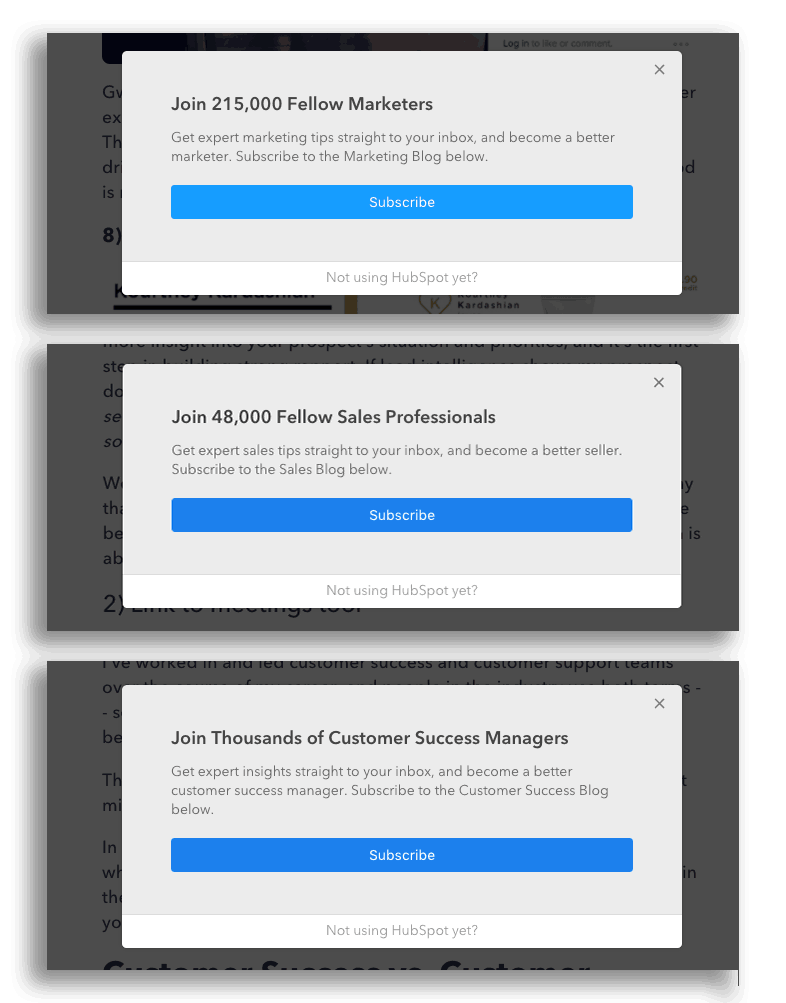
2. Get the right tools
Regardless of what use cases you choose to put in place, you will need to find the right technology partner to implement them.
There are several essential criteria to consider:
- Whether your solution is able to take real-time into account so that factors such as reviews and stock counts are always up to date
- The possibility of updating your product pages based on stock numbers or customer reviews
- The possibility of placing popular products that are of interest to visitors in a prominent position
,
Kameleoon makes it very easy to use social proof:
- We draw on our sound knowledge of open-source technologies (Hadoop, Kafka, Spark, ElasticSearch, etc.) to offer a stable Big Data architecture and feed data to your back-office in real-time. Using our solutions it is therefore possible to update your social proof messages in real-time, based on your inventory levels, new customer reviews, or other criteria that you can decide on beforehand.
- Our Product & Price Targeting functionality enables you to cross-reference the popularity of your offerings against your visitors’ particular tastes (in terms of products, product categories and price ranges, for instance) and build them fully personalized customer journeys
- Our product API plugs into your inventory management solution, then displays social proof messages about stock numbers. All you need to do is send through the content of your product catalogue via a Kameleoon JavaScript API.
,
4 How to send the right social proof messages to the right visitors
Social proof can be a major ally when it comes to engaging and converting your visitors. However, not all visitors will be influenced by it and their experience can quickly be marred if it is poorly managed.
What impression do you get when you visit a website that bombards you with social proof and urgency-inducing messages throughout your journey? When a visitor receives too much marketing pressure, their experience can become unpleasant to the point where they might even abandon their visit.
AI-driven personalization enables you to identify whether a visitor prefers one message over another and to only display the most pertinent message for each visitor.
Our machine learning algorithms calculate visitors’ likes and dislikes in real time by studying their behavior on your website. Based on this real-time intention scoring (KCS™ - Kameleoon Conversion Score), a personalization is automatically triggered to individualize the messages presented to each visitor.
Several Kameleoon clients use this functionality to display the right social proof message to the right person at the right time.
Cdiscount
Cdiscount, for example, uses Kameleoon to prioritize the messages to which their visitors are exposed: social proof (over 82% of customers are satisfied, 50 orders already placed…), urgency (78% chance that the price will rise, Only 7 hours left for delivery the day after tomorrow), or informative (in stock, payment plan available).

This AI-driven targeting has increased Cdiscount’s conversion rate by 5%.
Vertbaudet
Vertbaudet is another client that decided to use our predictive targeting solution to trigger individually targeted social proof messages that therefore have the biggest impact on conversion.

Visitors to the Vertbaudet website are categorized according to their susceptibility to different urgency messages, and only the message that is the most relevant for that visitor is displayed.
How does it work?
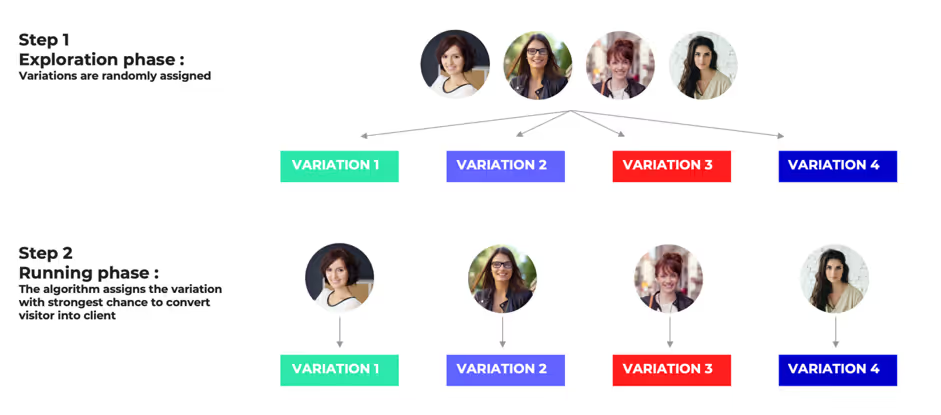
Don’t miss out on the opportunities social proof offers
real-time personalization capabilities that a solution like Kameleoon offers, you can go even further by building relevant experiences for your different visitor segments.

,
FAQs about social proof in ecommerce
What is social proof and why does it matter?
Social proof is a psychological principle where people copy the actions of others when making decisions. In ecommerce, it matters because showing reviews, real-time purchases, and popularity indicators builds trust and drives conversions.
What are examples of social proof on a website?
Examples of social proof include customer reviews, the number of purchases or add-to-carts, stock countdowns, and visitor counters on product pages. Platforms like Netflix also show trending content to guide user behavior based on what others are watching.
How does social proof increase conversion rates?
Social proof improves conversion by reducing uncertainty. It does this by showing that others have made the same decision. When users see that a product is popular or selling quickly, they are more likely to act. This taps into urgency and trust—two key drivers of conversion.
How can I personalize social proof for different users?
Using a tool like Kameleoon, you can personalize social proof by showing the most relevant messages to each visitor. For example, display local best-sellers or trigger urgency messages only when a user is likely to respond to them, based on real-time behavior.
What’s the difference between social proof and urgency tactics?
Urgency tactics create time pressure (like limited-time offers or countdown timers), while social proof builds confidence by showing that others trust or buy a product. Together, they work powerfully—but they must be targeted carefully to avoid overwhelming the visitor.




